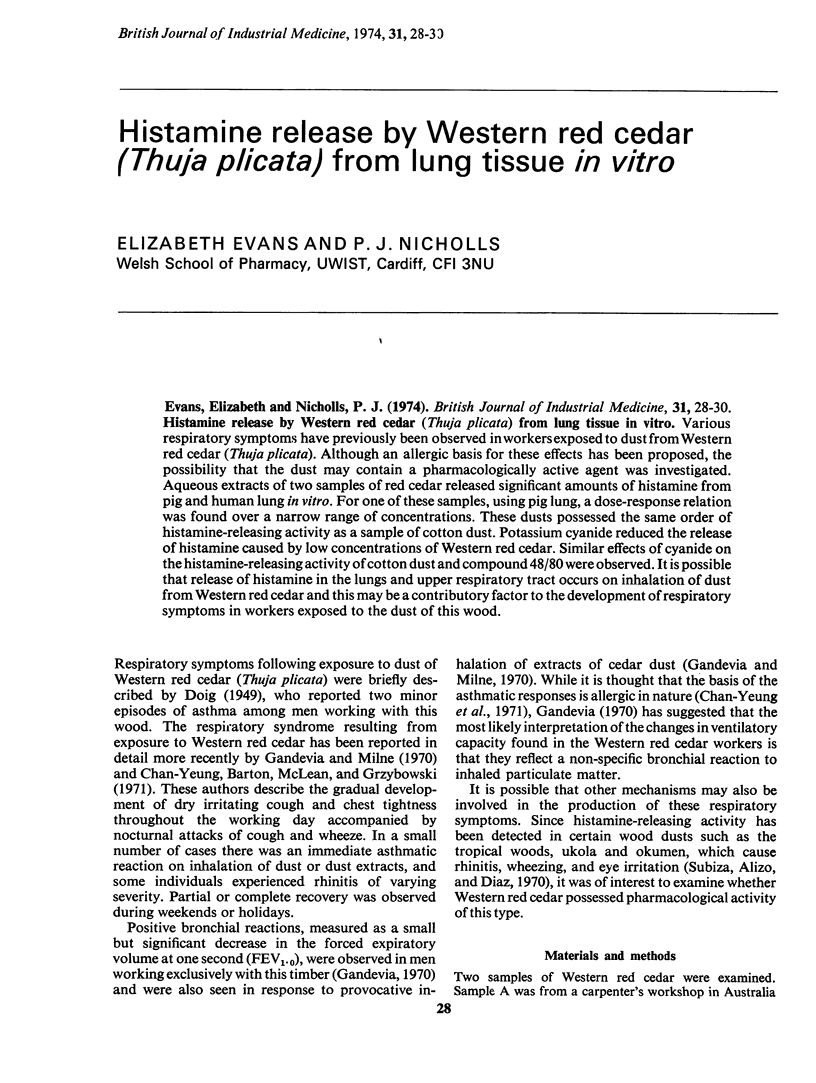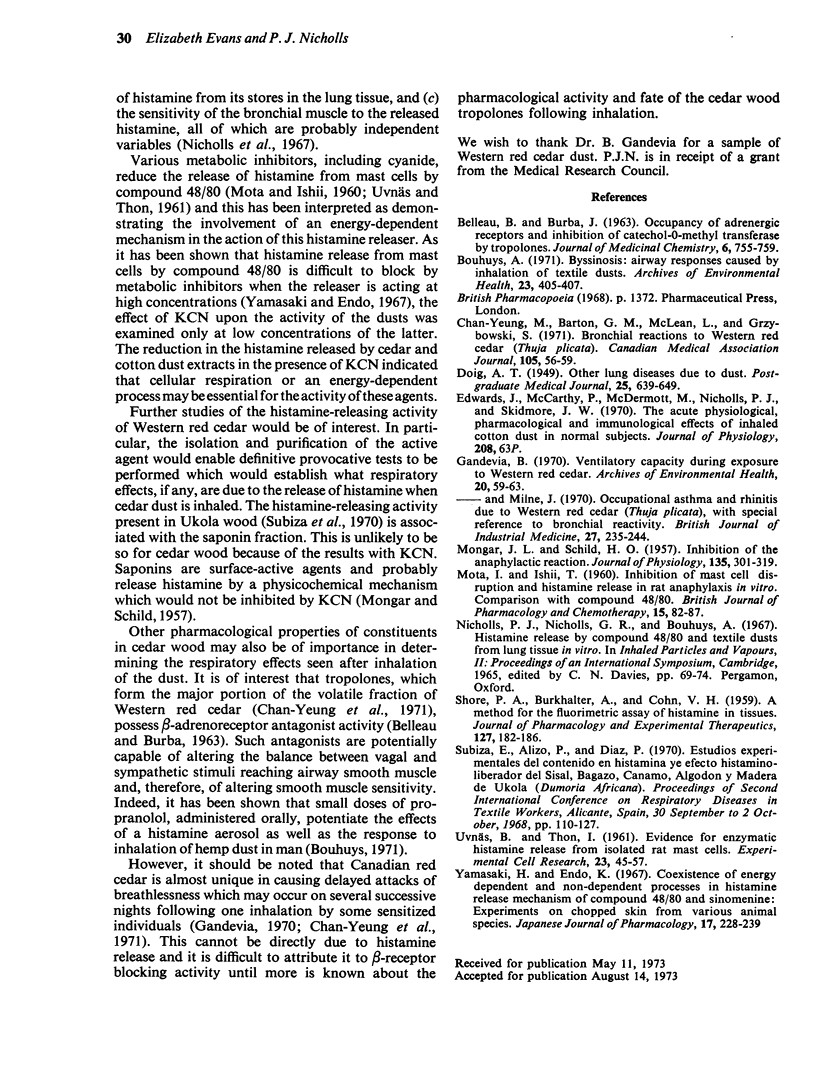Abstract
Evans, Elizabeth and Nicholls, P. J. (1974).British Journal of Industrial Medicine,31, 28-30. Histamine release by Western red cedar(Thuja plicata)from lung tissue in vitro. Various respiratory symptoms have previously been observed in workers exposed to dust from Western red cedar (Thuja plicata). Although an allergic basis for these effects has been proposed, the possibility that the dust may contain a pharmacologically active agent was investigated. Aqueous extracts of two samples of red cedar released significant amounts of histamine from pig and human lung in vitro. For one of these samples, using pig lung, a dose-response relation was found over a narrow range of concentrations. These dusts possessed the same order of histamine-releasing activity as a sample of cotton dust. Potassium cyanide reduced the release of histamine caused by low concentrations of Western red cedar. Similar effects of cyanide on the histamine-releasing activity of cotton dust and compound 48/80 were observed. It is possible that release of histamine in the lungs and upper respiratory tract occurs on inhalation of dust from Western red cedar and this may be a contributory factor to the development of respiratory symptoms in workers exposed to the dust of this wood.
Full text
PDF


Selected References
These references are in PubMed. This may not be the complete list of references from this article.
- BELLEAU B., BURBA J. OCCUPANCY OF ADRENERGIC RECEPTORS AND INHIBITION OF CATECHOL O-METHYL TRANSFERASE BY TROPOLONES. J Med Chem. 1963 Nov;6:755–759. doi: 10.1021/jm00342a028. [DOI] [PubMed] [Google Scholar]
- Bouhuys A. Byssinosis. Airway responses caused by inhalation of textile dusts. Arch Environ Health. 1971 Dec;23(6):405–407. doi: 10.1080/00039896.1971.10666028. [DOI] [PubMed] [Google Scholar]
- Chan-Yeung M., Barton G. M., McLean L., Grzybowski S. Bronchial reactions to western red cedar (Thuja plicata). Can Med Assoc J. 1971 Jul 10;105(1):56–passim. [PMC free article] [PubMed] [Google Scholar]
- DOIG A. T. Other lung diseases due to dust. Postgrad Med J. 1949 Dec;25(290):639-49, illust. doi: 10.1136/pgmj.25.290.639. [DOI] [PMC free article] [PubMed] [Google Scholar]
- Edwards J., McCarthy P., McDermott M., Nicholls P. J., Skidmore J. W. The acute physiological, pharmacological and immunological effects of inhaled cotton dust in normal subjects. J Physiol. 1970 Jun;208(2):63P–64P. [PubMed] [Google Scholar]
- Gandevia B., Milne J. Occupational asthma and rhinitis due to Western red cedar (Thuja plicata), with special reference to bronchial reactivity. Br J Ind Med. 1970 Jul;27(3):235–244. doi: 10.1136/oem.27.3.235. [DOI] [PMC free article] [PubMed] [Google Scholar]
- Gandevia B. Ventilatory capacity during exposure to western red cedar. Arch Environ Health. 1970 Jan;20(1):59–63. doi: 10.1080/00039896.1970.10665542. [DOI] [PubMed] [Google Scholar]
- MONGAR J. L., SCHILD H. O. Inhibition of the anaphylactic reaction. J Physiol. 1957 Feb 15;135(2):301–319. doi: 10.1113/jphysiol.1957.sp005712. [DOI] [PMC free article] [PubMed] [Google Scholar]
- MOTA I., ISHIT T. Inhibition of mast cell disruption and histamine release in rat anaphylaxis in vitro. Comparison with compound 48/80. Br J Pharmacol Chemother. 1960 Mar;15:82–87. doi: 10.1111/j.1476-5381.1960.tb01213.x. [DOI] [PMC free article] [PubMed] [Google Scholar]
- SHORE P. A., BURKHALTER A., COHN V. H., Jr A method for the fluorometric assay of histamine in tissues. J Pharmacol Exp Ther. 1959 Nov;127:182–186. [PubMed] [Google Scholar]
- UVNAS B., THON I. L. Evidence for enzymatic histamine release from isolated rat mast cells. Exp Cell Res. 1961 Feb;23:45–57. doi: 10.1016/0014-4827(61)90062-3. [DOI] [PubMed] [Google Scholar]
- Yamasaki H., Endo K. Coexistence of energy-dependent and non-dependent processes in the histamine release mechanism of compound 48-80 and sinomenine: experiments on skin from various animal species. Jpn J Pharmacol. 1967 Jun;17(2):228–239. doi: 10.1254/jjp.17.228. [DOI] [PubMed] [Google Scholar]


